If you’ve ever been to Kutná Hora in the Czech Republic then chances are you’ll be familiar with their most famous tourist attraction: The Church of Bones. This is not just a name either The Church of Bones is literally made out of human bones. In the 13th century CE, a priest came home from Palestine with a pocketful of soil that he then sprinkled in the cemetery that surrounded the Chapel of All Saints. From that point on the graveyard was an overwhelmingly popular burial site (especially for aristocrats). In fact it was so popular that they quickly ran out of space so they began exhuming bodies in order to make room for newcomers. The remains that were exhumed from the graveyard were placed in the chapel. The bones grew so many that by 1870 František Rint, a woodcarver, was commissioned to use these bones as decoration for the chapel and to “create a reminder of the impermanence of human life and inescapable death”(site).This is exactly what he did.
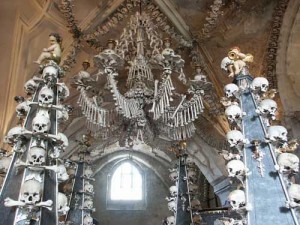 (site)
(site)
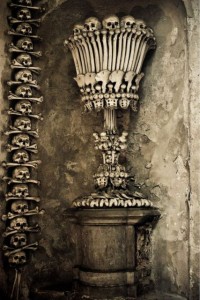 (site)
(site)
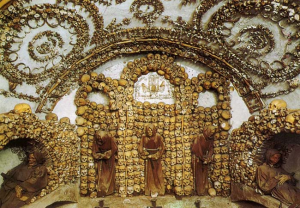 (site)
(site)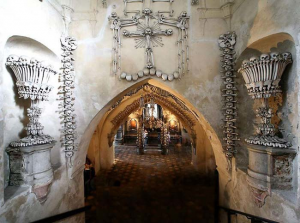 (site)
(site)
Even though this may seem very off topic for a history of urban development class it is a solution to aid in the functionality of this city. By means of being able to store upwards of 40,000 human remains in one chapel. Besides this, it is an undeniably beautiful (albeit creepy) piece of historical architecture that brings tourists in from all over the world. And The Church of Bones is not the only example of its kind.
Paris had a similar problem, it was such a popular city to live and die in that they too needed a solution for the large amount of human remains within the city. Therefore they built catacombs, and between the years 1786-1788 virtually all bodies in Paris were exhumed from their burial spots and placed in the catacombs. It somewhat resembles (to a lesser extent) the Church of Bones in the Czech Republic. However the catacombs hold upwards of an astonishing 6 million bodies.
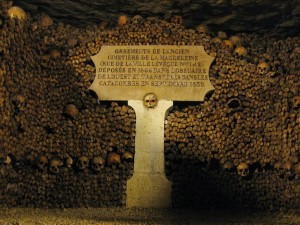 (site)
(site)
 (site)
(site)
 (site)
(site)
So it is easy to see that the catacombs of Paris are less artistic than the Church of Bones however both places managed to solve the same problem. They needed a new place to store or bury the exhumed bodies that were taking up all of the desirable grave plots so they found ways to not only store the remains but to turn them into points of interest for the cities themselves. Now they are seen as tourist destinations and there are people today who want to be part of these displays when they pass, which is in fact possible. Would you be interested in being a part of one of these displays?
SOURCES
http://www.outsideprague.com/kutna_hora/bone_church.html
Notes from ANTH 430 Tatiana Nomokonova. Nov. 2015
Photos:
http://sciencefactorama.blogspot.ca/2015/01/caves-of-human-corpses-catacombs-of.html
http://www.opposingviews.com/i/gallery/entertainment/cathedral-made-bones-incredible-sight

What do you think is the symbolic meaning of placing bones in places of worship?
Is it purely out of utility, to create easy storage for large amount of bones/bodies?
Is there some other kind of cultural significance or even a link to a historical trend or event that would cause people to use bones as decorations and building materials?
In the cases that I used I think it simply started as a means of preserving space. They needed to make room in the burial grounds therefore they dug up many bones and did not know what else to do with them. In the Church of Bones I read somewhere that it began by priests stacking them all to make space inside and some of them went a little crazy doing so that finally the owners of the church hired someone to come in and make them a part of the church. (I did read that a while ago now though so it may be off a bit). I don’t think there was a symbolic significance in these cases though but I’m sure you could find examples where there are.
I think it is a innovative way to dispose of bodies after death. Better then spending thousands of dollars on coffin and burial fees. Furthermore, you get to become a part of a “piece of art” that will attract curious visitors. It is an interesting outlook on death, more attracting than rotting in the ground. It also solve the space crises that many community (notably those of the catholic faith) are faced with, due to the always increasing size of the graveyards, more often then not, built on valuable land.
I think this concept is an interesting way to deal with the disposal of dead bodies, especially when the bodies in older cities begin to pile up. However at what point does the body undergo dissolution with the person that inhabited it. When does an association with that body end? At what point is it acceptable to publicly display a skeleton? If this trend continues does that mean we would see the skeletons of our friends and family eventually displayed? And when will they become display eventually? When will our own skeletons will be on display in cities for a touristic attraction?
I don’t know for sure if any living relatives were upset by the exhumation of their ancestors bodies, nothing like that came up in my research of Anthro class where this was discussed. Also my understanding is that these remains were so old that it is very unlikely that they had many living relatives that were concerned about them being put on display. Also I think that in today’s society the dead have more of a right than they did when this occurred therefore I do not think it would happen to a person’s remains who did not wish it. So if someone wishes to be a part of the display that is their decision, kind of like donating your organs or your body to science and so on. As far as a time frame for those that have not given permission I’m not sure there is a correct answer but again in this day and age I doubt that anyone could do this again without some kind of permission from the deceased or their relatives.
I agree with Christine, it is a much more cost efficient (and efficient use of space) way of disposing of bodies. I also think it gives an alternative way of thinking of death and human remains-painting a pretty picture almost.
Really cool post!
This use of human remains shows how people residing in different environments regard said use. While this does indeed prove to be cost effective, it does create a border between those who are intrigued by this practice and those who are horrified and sickened.
Nonetheless, a well written post.
This is super interesting I did not know this existed. It makes me a little uncomfortable, but it seems like such an interesting way to create a place where one would go to pay respects to the dead. Also an interesting way that one would pay respects to the national history.